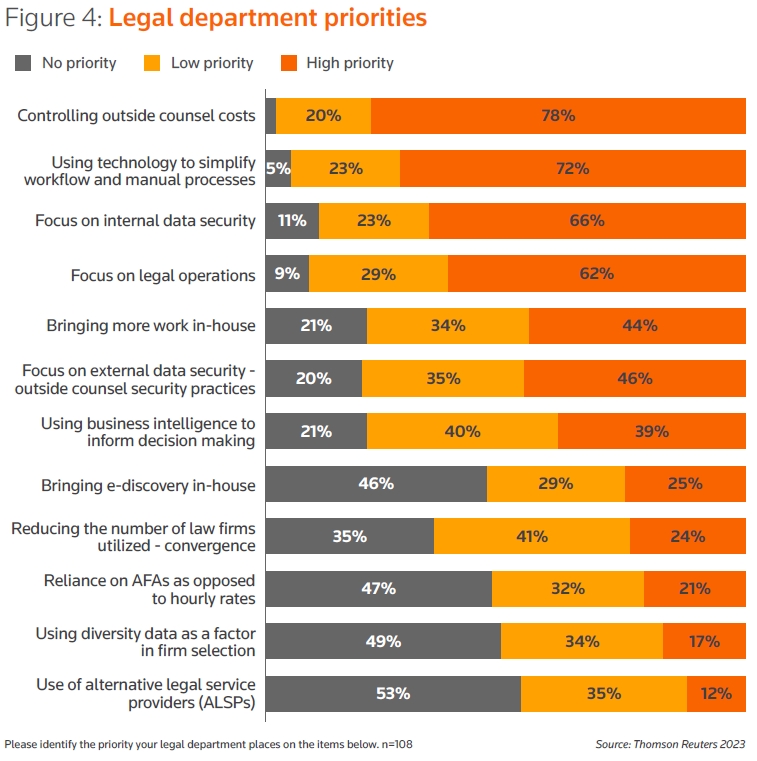In the latest "Legal Department Operations Index" report from the Thomson Reuters Institute and the Legal Value Network, we see how these professionals are balancing a myriad of challenges
Most research into corporate law departments focuses, understandably, on the opinions and priorities of the general counsel. After all, they are the corporate officers tasked with leading the legal functions of the businesses and ultimately watching out for companies’ best interests.
However, there is another team of professionals that plays a similarly important role in ensuring the legal protection of the enterprise — the legal operations professionals tasked with bringing the priorities of GCs to operational reality.
At the same time, legal department operations (LDO) professionals must also structure their efforts in a way that reflects the broader realities around them, including technology trends, economic influences, and the changing strategies and alignments of outside counsel law firms.
To better understand how LDO teams are balancing these often-competing interests, the Thomson Reuters Institute, in collaboration with the Legal Value Network, has published the latest iteration of our Legal Department Operations Index. This report is based on a survey — conducted through an online survey done in the U.S. in June and July — of LDO professionals from businesses ranging in size from under $500 million in annual revenue to more than $10 billion in revenue from a variety of industries. The report is structured to help ascertain what LDO professionals view as their biggest challenges and priorities.

Among the key findings in this report:
-
- A large majority of corporate law department are experiencing an increase in the volume of legal work, while at the same time, are trying to handle an increasing share of their workload in-house rather than using outside counsel.
- Nearly two-thirds of law departments report that total department budgets are either flat or decreasing, further reinforcing the do-more-with-less In a related finding, attorney headcount is unchanged for the majority of departments, meaning the increased work volume is placing a greater strain on in-house lawyers. And while LDO professionals want to place a greater focus on legal operations, these headcount and budget pressures are making that difficult.
- A majority of law departments also report an increased use of legal technology tools over the past year, despite a generally slow pace of new technology adoption. Further, many departments are increasingly using these tools to help manage workflows.
Not surprisingly, controlling outside counsel costs remains the top high priority item on LDO agendas. Fortunately, efforts to control costs — particularly with regard to law firm rates — appear to be bearing fruit, although more innovative ways to price and track legal work remain uncommon.
However, most law departments also report the share of their budget devoted to legal technology is remaining flat, which means that corporate law departments looking to increase operational efficiency via technology need to get a higher return on their technology investment to see increasing value out of their spend.
LDO professionals must structure their efforts in a way that reflects the broader realities around them, including technology trends, economic influences, and the changing strategies and alignments of outside law firms.
The report also points out that the particular metrics tracked by LDO teams cover the financial aspects of the law department well, but such measurements may not be comprehensive enough to provide a broad overview of all areas of responsibility. And additional questions around how legal teams work, the threats posed by data security issue (which are an increasing concern for LDO professionals), and return-to-office policy remain common, with many law departments seeing their policies set at the corporate level.
This report also shows how a better understanding between GCs and LDO teams — around issues of where they may be in alignment, where there may be a difference in perspective, and how to benchmark themselves against their peers — would be a boon to individual law departments. It also sheds light onto areas of potential improvement, particularly related to tech adoption and budgeting, as well as the metrics used to gauge and report department performance.
Similarly for law firms, this report provides needed insight into which areas in-house law departments are looking for assistance. Law firms that can step up to provide some of this assistance — for example, by helping to track key performance metrics beyond just cost factors — could potentially bring value to their clients well beyond just the legal matters for which they’re engaged.
You can download a copy of the 2023 Legal Department Operations Index here.







